I’ve been very busy the last couple of days, and the busy-ness doesn’t look like it’ll come to an end soon. My husband, therefore (and what a model of husbandly devotion!) offered to write the review of Abe-Hayat for me. This, mind you, without having seen the film, just on the basis of a very sketchy gist I’d narrated of the first half while we were on our evening walk. Tarun said he’d do a 3-sentence review:
Once there was an evil jaadugar named Saamri. There was a prince, and a princess. The prince killed Saamri, and then he and the princess lived happily ever after.
Not bad, actually. It just shows how easy it is to predict a Hindi fantasy film from the 50s.
For those of you who want a bit more from a review (and who want the truth, because Tarun did get it slightly wrong), the following might help.
To begin with, Saamri (? I can’t identify this actor, probably because his whacky eyebrows and that curly wig, beard and moochh get in the way. Later note: Anu tells me he may be SL Puri. I envy her powers of discernment. Through all that hair, too! Wah). Saamri is very evil. This you can gauge by the fact that, on the very day they were to get married, he abducts two of the beautiful daughters of the ruler of Halam. (Further watching convinces me that Saamri is mostly just a very desperate lecher who will do anything to get a woman – any woman – to marry him. I feel a bit sorry for him. I’m sure that hairdo isn’t his fault).
One of the two princesses kills herself, but the other one, Rukhsana (?) has better luck: she is befriended by the Sabz Pari (literally, the ‘green fairy’; Ameeta), who is Saamri’s sister. The Sabz Pari tries to teach Rukhsana how to handle Saamri and keep him dangling.
Unfortunately for her, her brother comes along just then and gives the Sabz Pari what for – by changing her into a marble statue. She makes a rather decorative life-size garden ornament.
We now switch to the present, back to the kingdom of Halam. The poor of Halam are a happy lot, because they’ve found an unlikely champion: Jalal (Premnath), the son of the Wazir of Halam (?). Jalal spends his time snatching fruit off stalls and giving it to street urchins, or whipping the turbans off the heads of passing noblemen. The poor reciprocate by dancing along with him when he goes singing through the streets. They don’t seem to notice that for all his democratic ideals, Jalal’s as gorgeously dressed as any of those aristos.
Unknown to him, Jalal is not the only richly-clad member of the nobility to feel for the poor. The one remaining princess of Halam (remember? Her sisters were carried off by Saamri) is Shahzaad (Shashikala), a feisty, strong-willed female who can wield a mean sword…
… and is not above defying her mother (Ruby Myers) and father (Mubarak). When they stop her from wandering out of the palace to see how the rest of Halam lives, Shahzaad disguises herself as a young man, moustache and all, and goes out by herself.
She ends up in a seedy little place which is certainly a gambling den, and half of which looks like a tavern. [Something wrong with the setting, there? Everybody in this film goes “Ya Allah!” at the drop of a hat, and there are other allusions to Halam being a staunchly Islamic land]. One of the seedier elements here is Aqeel (Pran), who is the prince of a neighbouring land. Aqeel has been sent by his father to pester Shahzaad’s dad to repay a long-overdue debt of 80,00,000 dinars (what on earth did he do with all that money?!)
The Sultan has got his Wazir to carry out the negotiations with Aqeel, and the result has been that Aqeel has given an ultimatum: repay in 8 days’ time, or else. Now Aqeel is spending those 8 days gambling – and winning, and sniggering evilly as he robs some poor soul blind (the poor soul, being so poor, should not have been gambling in the first place).
Fortunately for the poor soul, Jalal steps in and gambles, reducing Aqeel to a shambles. [I think that’s rather poetic. At least it rhymes.]
There’s also a pretty dancer (Helen), whom Aqeel leers at and tries to fondle. This results in a brawl, with furniture and men flying in all directions. Poor disguised Shahzaad gets knocked on the head, and is rescued by Jalal and his good friend Sharfu (Ram Avtar). They drag ‘him’ off to the hakim, who administers a bitter potion that will heal ‘his’ bruises, but which immediately makes ‘him’ drowsy. No-one knows where this stranger has come from, so Jalal carries ‘him’ to his own home, even accommodating the stranger in his own bedroom (not in his bed, though; that would be too scandalous for 1955 Hindi cinema).
In the course of the night, Shahzaad’s disguise goes for a toss. There’s a moment of awed silence as Jalal and Shahzaad (who till now has been in a stupor and hasn’t had a good look at Jalal) stare at each other. The next moment, of course, they’re in love and singing it out loud. [How come people in a fully occupied house or mansion can sing loud and clear at night with nobody waking up? Naujawaan was an exception].
This is followed by many a loving rendezvous. Shahzaad sneaks out every night to meet her beloved and sing yet another song, while her resourceful maids think up creative ways to keep Shahzaad’s parents from realising she isn’t in bed.
In the meantime, Shahzaad and Jalal’s romantic interludes have become just that: interludes. They’re interrupted constantly, by wandering lions (whom Jalal quickly dispatches), by Sharfu (who seems to act as an errand boy) and by Aqeel (who kidnaps Shahzaad and then realises how lovely she is).
Jalal, being Jalal, manages to rescue her from both Aqeel and the lion.
When Shahzaad’s parents discover (as they were bound to, sooner or later) that she’s been gone all night, she tells them of how she’d been attacked by a lion and then saved by Jalal. (She omits to mention being almost mauled by Aqeel too, an omission which will prove costly).
Shahzaad’s parents are very grateful to Jalal for having saved their darling daughter, and he is summoned to court. The Sultan generously orders him to “ask for whatever you wish” – and Jalal asks for Shahzaad’s hand in marriage. The result being that he is instantly exiled. This horrid task has to be carried out by his own father, the Wazir, who goes through much battling with his conscience before he can bring himself to put professional loyalty before paternal affection.
Meanwhile, that 8 days’ grace that Aqeel had accorded Halam are up. He now comes to the Sultan and starts pestering him for the 80,00,000 dinars due. When the Sultan admits that he’s broke, Aqeel offers to forgive the debt – if Shahzaad will become his wife.
Since the Sultan has no option (and since he doesn’t know Aqeel for the lowlife he really is), he agrees. Shahzaad will be married to Aqeel.
Jalal’s loyal old pal Sharfu immediately goes off to report this to Jalal (who, conveniently, seems to be hovering right outside the borders of Halam). Jalal, suitably angry at the thought that his girl will be married off to another, goes charging back into Halam and the Sultan’s palace, and arrives just in time to prevent Shahzaad being manhandled by Aqeel, who’s been trying to woo her. [This man needs lessons in wooing.]
A duel ensues, which is interrupted by the Sultan, his Sultana, the Wazir, Jalal’s mother, and just about every other Tom, Dick and Harry in Halam. The Sultan is miffed that Jalal has disregarded the banishment imposed on him, and commands the Wazir to arrest and kill Jalal.
Though he tries to resign, the Wazir is bullied by his boss into arresting Jalal.
Our hero ends up in jail, awaiting his execution. And Aqeel’s parents arrive (his mother is played by Mumtaz Begum, though I couldn’t identify his dad behind all that shrubbery). Arrangements are made for the wedding, and Shahzaad whiles away her time by singing sad songs, mourning her to-be-hanged sweetheart and her impending marriage to Aqeel.
On the day of the wedding, even as the ceremonies begin, the inevitable happens: Saamri lands up and carries off Shahzaad! [How does he know when one of the princesses is getting married? ESP? Why does he wait till the last moment? Why doesn’t he kidnap them before? Does he kidnap any other girls just before they’re married? So many questions that remain unanswered].
Pandemonium prevails. There’s much shrieking and weeping, and the Sultan – Shahzaad’s father – passes out after Saamri puts a spell on him. Actually, good for the Sultan, considering that now:
(a) he will either have Saamri or Aqeel for a son-in-law, and neither of them is exactly endearing;
(b) if it isn’t Aqeel, he (the Sultan) will have to figure out a way to return those 80,00,000 dinars
(c) the good guy is going to be executed any minute now
The shahi hakim (the imperial physician) is sent for, and after some examination, announces that the only substance that can restore the Sultan is the ‘water of life’, the aab-e-hayat.
But who will fetch the (notoriously difficult to obtain) aab-e-hayat? A public proclamation is ordered, and Jalal hears it just as the black bag is about to be slipped over his head. And being the loyal subject that he is, he pushes the executioner aside and sets off to beg permission to be allowed to go find the aab-e-hayat – and Shahzaad, of course.
Much will happen. Jalal will encounter strange and magical beings in his quest for sweetheart and sweetheart’s daddy’s life. He will find himself being pursued by two starry-eyed fairies: Sadabahaar (Smriti Biswas):
… and the Sabz Pari (don’t ask how she turns back to living being from statue):
There will be flying carpets:
– and magical horns that will have strange effects. There will be djinn and more fairies; there will be flying thrones and peppy nightclub-like dances. There will be Saamri, twirling his bone-like wand (ugh!) in front of a vast (but disproportionate) skull. And there will be loads of adventure.
What I liked about this film:
There’s a quaint charm about the fantasy of it all – and both Shashikala and Premnath have a flair for comedy that is particularly delightful in the first ten minutes or so of Jalal and Shahzaad’s meeting. In fact, there’s a good bit of humour in the first quarter of the film, what with Shahzaad trying to sneak away to meet Jalal, and her maids trying to keep the Sultan from knowing what’s up.
The special effects, too, especially for that day and age, aren’t bad at all. The flying carpets and so on don’t look completely artificial, and though Saamri’s den is silly (and I wouldn’t really think balloons would have been a part of a supposedly medieval land like Halam), the rest of fairyland looks passable.
The music. Sardar Malik (father of the – ahem – music director Anu Malik) composed for only a handful of films, and this was one of them. The pièce de resistance of this score is the superb Main gareebon ka dil hoon watan ki zubaan; but there are others too which I liked a lot, prime among them being Ik jaan meri aur laakh sitam and the Geeta Dutt song, Mera dil meri jaan chaahe le le.
Oh, and the eye candy! Premnath, Shashikala, Ameeta, Smriti Biswas… lots of beautiful people here. There’s a very young Helen too, as a dancer in the tavern where Shahzaad first meets Jalal:
And, just because everybody else looks so wonderful too, some more screenshots:
What I didn’t like:
All those unresolved questions. And the melodrama that swamps the story every now and then, mostly when it’s Jalal or Shahzaad and their parents.
Still, lots of entertainment here. The entire story may not make sense; one of the villains may seem to be unjustly maligned; and at least half an hour could have been chopped off with no questions asked – but it’s still good fun.
P.S. Why, if Shahzaad was such a good fencer, did she not fight back when being carried off by ruffians like Saamri and Aqeel? A waste of a fencing master and some good swords.
P.P.S. Later note:
With much thanks to pacifist, who solved the mystery of the sabz pari, who despite her name, was not a ‘vegetable fairy’, but a ‘green fairy’. It now turns out that her name may literally have meant that (sabz being ‘green’ in Urdu), but it also means ’emerald fairy’. And, according to the nautanki play called Indrasabha, the Sabz Pari or Emerald Fairy was a fairy in the realm of Indra. She fell in love with an earthly prince named Gulfam, a union (or proposed union) that drew much flak from all and sundry. You can read about it here, in the last paragraph on the web page.
(And, thanks to pacifist, hear about it in song, here.)
That tradition, of course, explains why the Sabz Pari in Abe-Hayat is so smitten by Jalal – it’s the old story of fairy and earthling. This Sabz Pari’s story doesn’t turn out as happy as the traditional tale (thanks to the existence of Shahzaad), but anyway.

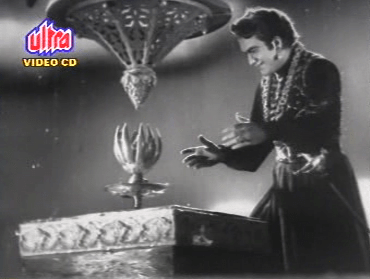
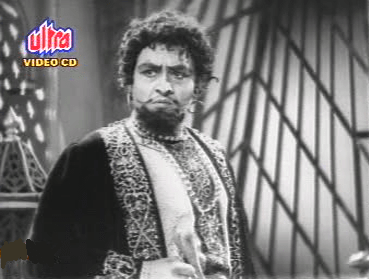
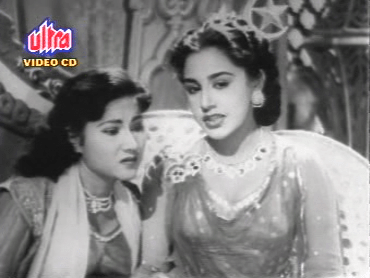

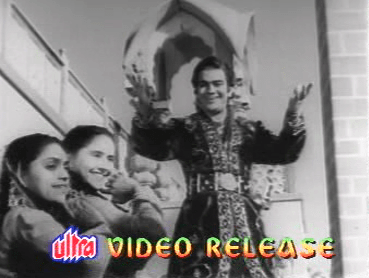


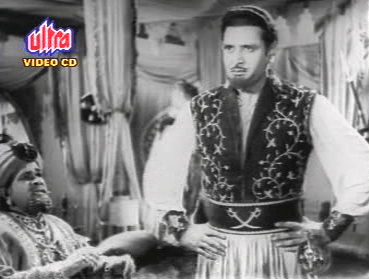

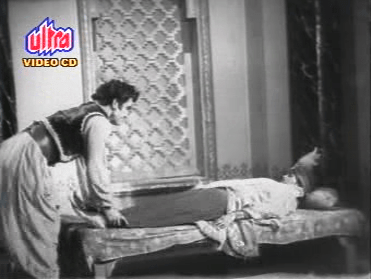



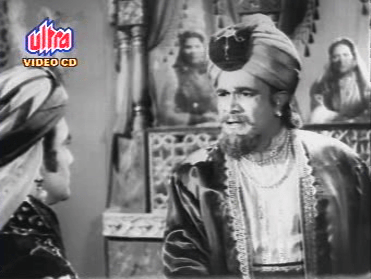


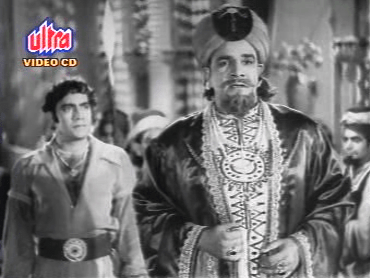
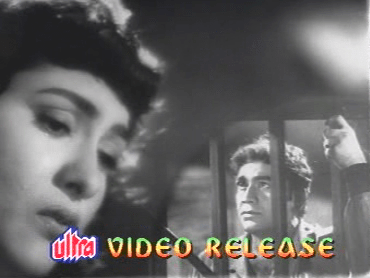

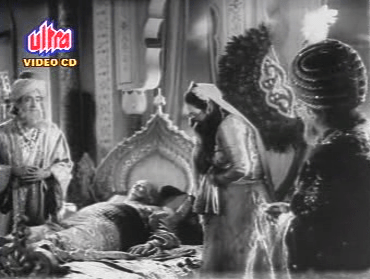
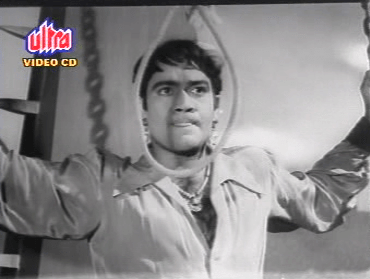
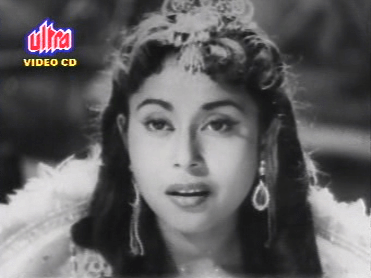

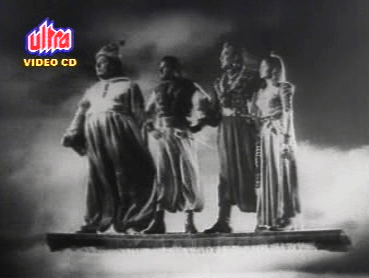
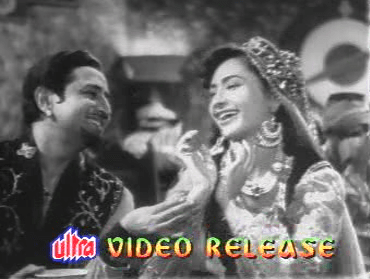

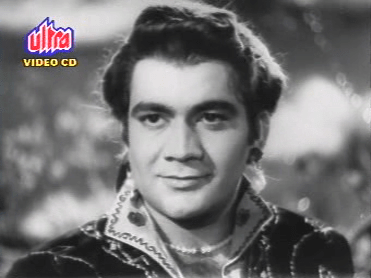
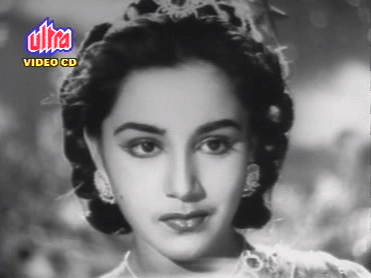
ROTFL!!!!!!!!!!!!!!!!!!!!!!!!!!!!!!!!!
Tarun should start a blog of his own! Film summaries in three lines!
Have jotted some thoughts as they flew through my mind while reading your hilarious review!
Here they are:
If his sister is a fairy, why isn’t Saamri himself, ahem… a fairy?
then atleast he wouldn’t abduct princesses! ;-)
Jalal seems to have learnt the strings of capitalism. He steals and gives it to the poor. He doesn’t at all think of changing the laws for the better. This easy solution lets him have good clothes for himself and the adulation of the poor! Most probably he had already planned to be next Sultan!
“what on earth did he do with all that money?!”
Lost it in the gambling den? Well, gambling might be prohibited, but if the owners bribe the officials well, I think no amount of ‘ya allah’ing can stop it.
“Jalal steps in and gambles, reducing Aqeel to a shambles.”
Waah, waah! Suhan Allah!
“How come people in a fully occupied house or mansion can sing loud and clear at night with nobody waking up?”
You mean you haven’t read the laws governing the hindi cinema? The Hindi film song act has regulated that!
“Why, if Shahzaad was such a good fencer, did she not fight back when being carried off by ruffians like Saamri and Aqeel?”
The female fencing in Indian cinema has regulated that though the heroine may possess superb fencing skills, whe may use it only to protect herself or impress the hero. There is loophole though. She can fight of the villain as well, if she has the title role or the hero is a new entrant to the cinematic world!
But the film does sound like loads of fun! Premnath doesn’t look that good here, does he? His nose growth syndrome has already started to afflict him!!
LikeLike
:-D
This is what I call a good, analytical commentary on a film. Thank you for all your delightful answers to my questions. I’m not sure I’m convinced, but it’s better than being completely in the dark!
Yes, I haven’t figured out why Saamri isn’t a fairy too. But he has a gang of henchmen who can shapeshift between fairy and bearded-clawed-ugly djinn-like creatures, so maybe this is just one of his avatars. Perhaps he’s so mean because he feels repressed at the thought of actually being a fairy…
Your unravelling of Jalal’s strategies re: democracy vs. monarchy is fabulous! I’m sure that’s IT! :-D
The Sultan is too righteous to gamble. But I’ve just remembered: his two eldest daughters were carried off by Saamri just as they were about to be married. Perhaps he had borrowed the money to pay for their weddings? And because the weddings never happened, all that money went down the drain.
And now that I think of it, Fearless Nadia is really the only female in old Hindi cinema whom I’ve seen actually holding her own totally in a fight. Yes, Meena Kumari did whack someone on the head in Kohinoor, and there have been other feisty ladies, but mostly the feistiness is just for show. When there’s a hero around to do the dirty work (like write reviews for you), why do it yourself?
Yes, Premnath was already beginning to look not-that-awesome here. And mind you, this only 4 years after Naujawaan. He’s not fat, but his face looks oddly pudgy.
LikeLike
“Perhaps he’s so mean because he feels repressed at the thought of actually being a fairy…”
Hello, Sigmund Freud!
“The Sultan is too righteous to gamble.”
Maybe he is so self-righteous that he does gamble! ;-) But your argument sounds plausible too!
And as to why Saamri kidnaps brides, maybe he has a weakness for women in bride attire, or since he negates his fairy background, he likes to compensate it by dressing himself as a bride.
“When there’s a hero around to do the dirty work (like write reviews for you), why do it yourself?”
ROTFL :-DDDD
Premnath in Naujawaan! *sigh*
LikeLike
“Hello, Sigmund Freud!”
That’s what cinema writing is all about, no? One can’t get away with just writing the synopsis and hoping people will visit your site for that. There have to be in-depth analyses of why this camera angle, or the significance of a particular dialogue, or why that particular shade of pink in the vamp’s lipstick… ;-)
BTW, your conjectures on why Saamri may be kidnapping brides seem to suggest that here’s another Sigmund Freud! Hello! :-D :-D
Wasn’t Premnath gorgeous in Naujawaan? Incidentally, I have come to the conclusion that even in his heyday, Premnath generally looked his best with his mouth shut – his teeth had big gaps between them, so half his handsomeness disappears when he grins.
LikeLike
“…why that particular shade of pink in the vamp’s lipstick… ;-)”
ROTFL :-DDDD
That’s true! That’s important! Particularly for b/w movies. ;-)
“here’s another Sigmund Freud! Hello!”
We are such good Freudians! BTW do you know what Freude means? It means happiness/joy. I dialect one says Freud. So we are jolly good fellows!
“Wasn’t Premnath gorgeous in Naujawaan?”
That’s like saying, the sun is bright. *sigh*
“his teeth had big gaps between them”
(in my best Monty Python voice) Oh dear, did he? What a shame! ;-)
But seriously, you mean there is no charm in his goofy grin?
LikeLike
Ah, I had no idea Freude meant joy – yes, we are jolly good fellows. (I am reminded of a dialogue from the Pakistani TV series, Dhoop Kinare; it went something like this: “Haan, koi aur nahin kehta hai ki main khoobsoorat dikhti hoon. Toh mujhe khud hi kehna padta hai”) ;-)
Seriously, I find no charm whatsoever in Premnath’s goofy grin!! Give me a Premnath who looks like this: …and I will swoon all over his feet. – but he MUST not be grinning.
…and I will swoon all over his feet. – but he MUST not be grinning.
LikeLike
Don’t know Dhoop Kinare, but it does make sense!
And here I go again! Sigh!
how about a screen shot with his grin? *nudge, nudge, wink, wink*
http://www.youtube.com/results?search_query=nudge+nudge+monty+python&aq=4&oq=nudge
LikeLike
Is this grin goofy enough for you?
(Though I think it’s supposed to be more evil than goofy, since he was the villain in Aan).
LikeLike
Madhu, how about 10 best of the less popular music directors?
1.Sardar Malik
2.Ganesh
3.Dileep Dholakia
4.Iqbal Qureshi
5.Baabul
6.Ramlal
7.Dattaram
8.Satish Bhatia
9.Sonik Omi
10.S.Mohinder
How many do we remember, these guys have given memorable tunes!!
LikeLike
Great minds think alike! ;-) I had already got that planned, and had even made out a rough draft of which music directors I’d include in my post. There are some overlaps with the list you’ve suggested, but there are a few I’d thought of which you don’t list (and vice-versa). Will do that list soon!
LikeLike
Great, look forward to it. Lets add SN Tripathi too, what songs he composed!!
LikeLike
True! And for so many films too. Unfortunately, most of the films he composed for seem to have been mythologicals or fantasy – the sort of stuff that didn’t run to silver jubilees or anything close. But S N Tripathi’s music certainly prevailed.
LikeLike
I have been giggling non-stop over this review! And I want to watch this film! *stamping foot* I want, I want, I want! I am a sucker for raha-rani-pari-djinn movies. And this one seems particularly blessed in that department!
And please tell your husband that I liked his review too. In fact, if he would do three-line synopses of the new movies, I will bend down and clasp his feet in gratitude! (I just saw an abomination called No, Thankyou. Actually, that is what I *should* have said, no?)
Wasn’t Saamri SL Puri? No?
Sabzpari sounds more like Vegetable Fairy. :) And thank you for identifying the disguised girl in the tavern for me. I had no idea it was Shashikala (and no, even the photo you posted here did not look like Shashikala to me!) when I was writing about the Helen song. *scurrying off to edit that post*
Jalal steps in and gambles, reducing Aqeel to a shambles.
Wah, wah! Wah, wah!
As for all your criticisms *humph*
1. Premnath is wearing expensive clothes because his parents already bought them for him – he has been taught ‘waste not, want not’. So there!
2. Halam is staunchly Islamic, but they are also democratic – so obviously the tavern / gambling den is owned by a non-muslim. And a good ruler must always encourage private enterprise. Hasn’t history taught you *anything*?
3. The ruler is in debt because of the meher for his daughters’ marriages – never mind that they were kidnapped before they could be wed. The meher must be paid – it is a debt of honour.
4. I am with harvey on this one. Denizens of moviedom are afflicted by Deafness Convenientitis, doncha know? Which is why the hero-heroine can sing songs any time, any place. (And with some ‘songs’, I wish I were deaf!)
5. C’mon *everyone* knows when the princesses are getting married – and Samri lives quite far away – it’s going to take him some time (in those days) to get from point A to point B. And I suppose he thinks that if the princess is ready to be wed, then why can’t he be the bridegroom? You can’t expect him to keep all princesses in mind all the time. He has so many other things to take care of – like turning his sister into a statue…
And how do you know that is not why he is going around kidnapping princesses? Because his sister has magical powers and he does not? Can you imagine the emotional trauma he must have gone through as a child? Knowing about his sister’s special powers? I can see him now, in a cupboard under the stairs, sobbing his heart out because he couldn’t conjure up a princess from a frog. And pulling his hair in frustration. (There. I have done my good deed for the day. I have given you a reason for his bad hair, and for his kaali kartoot.)
LikeLike
Arre, Saamri may live far away, but you forget: he’s a magician, no – he can command flying carpets and flying-other-modes of transport; he can get from his den to Halam faster than you can say “Beam me up, Scottie!”. But I guess you’re right about him thinking that if there’s going to be a wedding, he might as well be the bridegroom. The girl would already be all dressed and ready… come to think of it, he should have grabbed those princesses’ trousseaus while he was grabbing them.
(By the way, though his sister has magical powers, his outdo hers. So that can’t be the trauma that could have triggered off his spate of abductions). But I LOVE your explanation for his bad hair. :-D
A thought just occurred to me. Maybe Saamri, and not his sister, should be called ‘sabz‘ (which is Urdu for ‘green’, by the way) – he could be green with jealousy because he doesn’t have wings like his sister, and that’s what causes all this angst which manifests itself in this horrendous leching after Halam’s princesses…
I wonder, if Abe-Hayat had been filmed in colour, if Ameeta would really have been painted green.
LikeLike
P.S. Yes, Saamri could well have been SL Puri, since he was listed in the credits too. Will add it to my review. Thank you! And thank you for warning me off No, Thank you.
LikeLike
And thank you for warning me off No, Thank you.
You are most welcome. :) Consider it my good deed for the day. I almost felt like standing outside the theatre with a sign saying “Please enter at your own risk!”
And thanks to Pacifist for letting me get over the shock of seeing someone called a vegetable fairy! Yup, Emerald Fairy sounds *much* better. But poor Ameeta – forced to be a garden ornament when everybody else gets to prance around.
LikeLike
She does get to prance around, later in the film! :
LikeLike
Could you give me a ‘spoiler’ DO and tell me who gets Premnath – shashikala or Ameeta?
I feel very concerned about the sabz pari not getting the man she loves, and hoping that I’ve deduced this wrongly :-D.
LikeLike
C’mon, pacifist, Shashikala is the heroine. So you *know* she is the one who is going to get the hero! Haven’t you seen hindi films before? ;)
Besides, one never knows with paris who have evil magicians for brothers. Can you imagine coming home in the evening after singing songs with the adoring multitude and finding a life-size garden ornament where you left your wife?
LikeLike
But…but, but I thought Ameeta was the heroine. Shashikala has always been the one with a side character role. Unless in this earlier film Shashikala started as a heroine, but couldn’t make it as one.
LikeLike
Yid’s all bbery comblicated, pacifist. See, Ameeta could either be the fairy OR get the hero, not both.
LikeLike
Pacifist:
Spoiler ahead:
Shashikala isn’t the supporting character here, she’s the heroine (yes, that confused me too, when I first saw the film as a kid – I had always known Shashikala only as the nasty supporting actress). So, yes, she gets Premnath, Ameeta is left smiling sadly in the background.
Spoiler ends.
LikeLike
Thanks DO. How sad. :(
LikeLike
Not really – I found Shashikala both pretty AND rather endearing in this film. :-) Plus she’s good with Premnath!
LikeLike
Hoye, where are the sabz pari’s wings? I am disappointed!
LikeLike
The fairies have very fickle wings. They disappear conveniently when the fairy needs to dance and sing and be unencumbered, but they reappear when she’s not doing all that. (For instance, if you look carefully in that screen shot of Ameeta with Shahzaad’s older sister, you can see two curved white things – those are the wings – behind her shoulders). Don’t know why they vanished when Saamri turned her to stone, though.
It’s the same with Sadabahaar – very convenient wings.
LikeLike
Those were wings??? I thought they were the backs of the chairs on which they were sitting!
Reminds me that I’d better see some fantasy / fairy / magician / raja-rani films soon.
LikeLike
Yes, those were wings, not chair backs. Even the fluffy things on either side of Smriti Biswas’s neck in that screenshot of hers are wings!
If you get to see some good fantasy/raja-rani films, please tell! I generally like this genre a lot (I draw the line at Parasmani, which had ghastly special effacts – though awesome music)!
LikeLike
I found it quite interesting to note that Sardar Mallik had used the tune of Main garibon ka dil as the interlude in Kuchh bhi kaha na jaye. Another famous song which I can think of had this feature is Salil Choudhry’s Aa ja re pardesi in Madhumati whose interlude was the tune of Ghadi ghadi mora dil bhadke. My own feeling is that these composers could sense when they created something great and everlasting, and used those tunes in several ways in the film. One can think of many songs which would be repeated in a film in many variations.
LikeLike
Yes. It is often easy to tell when one’s own creation is good – I can invariably tell which of my stories are good and which aren’t!
Interestingly, besides using the tune of Main gareebon ka dil hoon as the interlude for Kuchh bhi kahaa na jaaye, Sardar Malik also used that as the sort of ‘signature tune’ of the film – every now and then, it appears as the background music.
LikeLike
Sounds rollicking!!! By the way, I’m still flummoxed as to why Ameeta didn’t garner much success as a lead actress. She does look so gorgeous and after seeing Tumsa Nahin Dekha and Goonj Uthi Shehnayi, I know that she was not a very bad actress after all!
LikeLike
It IS loads of fun. Not high-falutin’ cinema, and not terribly good fantasy either, but very entertaining.
My theory is that Ameeta didn’t do too well as a lead because she put on a lot of weight very rapidly – plus her voice was a little too squeaky. There are places in this film, for instance, where her voice was so high, it was cracking and I couldn’t figure out what she was saying. That said, she did act in some of my favourite films – including Tumsa Nahin Dekha, Dekh Kabira Roya and Munimji.
LikeLike
Great review, dustedoff! Btw, I can think of lots of movies that could do with your hubby’s three line synopses! Most recent ones would definitely qualify, which explains why I just went and picked up three DVD’s of Dilip Kumar, Raj Kapoor (only because it had Teesri Kasam in it) and Rajendra Kumar and then sat down to watch, to discover that they won’t play on my DVD player!
I thought Premnath was goodlooking in Barsaat, but that was about it – couldn’t stomach his nose and grin after that!
LikeLike
I shall certainly transmit everybody’s requests to my husband. In this day and age, 3-line reviews of films would probably attract a lot of people who don’t have the time to read long reviews!
Oh, so sorry your DVDs wouldn’t play. :-( That is odd, though – I can imagine one DVD not playing, but three? Very disappointing. I have the VCD of Halaku here beside me. A fresh new VCD, from Induna (whom I trust), but it just won’t play.
Premnath was good in Barsaat and in other early films like Aan or Sagaai or even Naujawaan – he’s very handsome in all of those, when he isn’t grinning. You can still see signs of that gorgeousness in somewhat later films like Changez Khan, but he began getting fat very soon.
LikeLike
LOLOLOLOL!!!!!
The review is gloriously funny, and so are the comments and responses. :-D
I think just for that it merits a viewing as soon as possible.
A sabz pari, raja rani, I agree with Anu – what more could one want.
Does Ameeta spend the entire film in stoney silence? What a waste. What’s Shshikala doing, singing and prancing around with the hero? Shouldn’t Ameeta be doing that?
Even without having seen the film I have so many questions. :-D
BTW the 3 sentence review of your husband’s is a good idea –
for contemporary films. Hahahahaha! I would definitely read them.
LikeLike
I’m so glad you liked the review, pacifist! :-)
No, Ameeta doesn’t spend the rest of the film in stony silence (I love that pun, by the way!) – she is revived (thanks to our hero’s efforts, even if they were only accidental), and she spends much of the rest of the film making eyes at Jalal and trying to get him to fall in love with her. He certainly smiles at her in a very dreamy sort of way!
Incidentally, Shashikala is very good at prancing around with the hero! This film, now that I come to think of it, has this in common with Jewel Thief: in both, the hero seems to be a magnet for lovely women – they seem to be drawn to him like iron filings to a magnet. And they have no compunctions making it obvious, too!
LikeLike
Sabz pari = vegetable fairy? She should be sange-mar mar pari.
Saamri is synonymous with evil – the villian/ghost in Purana Mandir is also the (in)famous Saamri. The movie was on TV last week and I quickly googled it to find out it was quite a trendsetter in the horror genre.
Who is Smriti Biswas? She looks familiar.
LikeLike
“Sang-e-marmar pari” :-)
BTW, sabz in Urdu means ‘green’ – but as I mentioned in my reply to Anu’s comment, above, I wonder if Ameeta would have actually been green if Abe-Hayat had been filmed in colour!
Yes, my husband (who seems to be a bit of an expert on Hindi fantasy films) was also telling me that Saamri was a major evil magician in Hindi cinema. Incidentally, if you’ve seen Dil Deke Dekho, Shammi Kapoor’s character in that pretends to be a magician named Saamri. But a good magician, who can solve all your problems.
Smriti Biswas was a minor actress who also acted in films like Jaagte Raho, Dilli ka Thug and Baap re Baap. She was also the dancer in one of my favourite nightclub songs:
LikeLike
Smriti Biswas was in Jaagte Raho? No wonder she looked so familiar. She’s opposite Pradeep Kumar in that movie, right? The one who meets him on the sly and RK walks in on them in her flat. Ok, now I remember her. :)
Btw, Jaagte Raho is an amazing movie. I loved through and through.
LikeLike
Yup, you’re right. She was opposite Pradeep Kumar in Jaagte Raho. And yes, it was an amazing movie. Even as somebody who doesn’t usually care for Raj Kapoor’s films, I’ll willingly admit it. Very well made.
LikeLike
SABZ-PARI must be some sort of a fairy from a tale.
Remember that song from KOHINOOR?
Gulfam ko mil gayi sabz-pari.
Only if they were in a ghoda-gaadi it could have been included in the list. Has a lovely clip clip rhythm though.
LikeLike
Pacifist, you’re a gem.
You’ve solved the riddle for me, and given me something intelligent to add to my completely whacky review! Am adding a note at the bottom of the review; it should appear within the next couple of minutes or so.
Bless you!
LikeLike
You’re welcome DO. :)
This is one of the reasons why I love old films. There’s so much one gets aquainted with, and learns – folklore/music etc etc Some things seem unbelievable (like the village woman finding out that the heroine is pregnant by checking her pulse), but were part of the rural medicine.
Now we know about the ‘nautanki traditions’ and sabz pari. After ‘teesri kasam’ nautanki fascinates me. :)
LikeLike
I think if we scratched the surface, we’d probably find a lot of nautanki influences on Hindi cinema – at least in the early years.
I remember reading somewhere that the Hindi film with the most songs was one called Indrasabha (which I suppose is the original one in which the Sabz Pari et al appear). It had a whopping 71 songs!
LikeLike
I am a fan of your writing but I gotta say that I loved Tarun’s review more this time :P I mean, the true mark of a writer is also that he can sum up 3 hrs into 3 sentences! :)
LikeLike
And a writer’s worth goes up even more when he can do so without:
(a) having seen the film
(b) knowing what happens after the first half
:-D
I shall let Tarun know!
LikeLike
Dunno about that, dustedoff. Half the reviewers in newspapers today seem to be writing through their hats! I read them, go for the movie, and then wonder whether they saw the same movie I did (or at all)!
You must have already seen the raja /rani movies I have, but off the top of my head (and I’m keeping the so-called historicals out of it) – Kohinoor, Aan, Azaad (the remake of an MGR movie called Malaikallan), Teen Sardar, Ghulam, Begum Badshah, Nishaan (1965), Sindbad, Alibaba aur Aladin (with a name like that, you have to expect fantasy!)… then there is something called Magic Carpet which makes me want to see it, but I cannot find it anywhere.
LikeLike
You’re right about the way most reviewers write – I’ve now reached the point where I don’t read reviews before going to watch a film. Also, sometimes I find that a review prejudices me – so it’s better not to have read one!
Thank you for your list of raja-rani movies – there were some there (Teen Sardar, Ghulam, Begum Baadshah and Nishaan) which I’d never heard of, but I’m off to see if my DVD rental guys have them! Incidentally, you can see how fond I am of raja-rani movies by the fact that my blog header includes a still from one (Nadira in Aan)/ :-)
LikeLike
Oh, and I forgot Halaku, and Sinbad the Sailor (hey, Pran is there – that’s worth watching just for that!), and Rani aur Lalpari (which I saw as a wee child; so I do not remember much of it). Alibaba and 40 thieves (Sanjeev Kumar, yet!) and Raja aur Runk …
I even love the thakur / haveli / type movies – to-tal masala :)
LikeLike
I have the VCD of Halaku, but it won’t play. :-(
Rani aur Lalpari was one of those quintessential kiddie classics, wasn’t it? I never saw it, though. But Raja aur Runk is fun (Sanjeev Kumar in young and very handsome avatar!), even better than the original Errol Flynn The Prince and the Pauper, I think – probably because of the songs. ;-)
Another entertaining raja-rani film is Ek Sapera Ek Lootera, with Feroze Khan and Kumkum.
LikeLike
Much as I love young-n-handsome Premnath, from your screencaps it looks like it is Pran who has more swashbuckle in him, here! I do wish he’d done some fun leading roles, before settling into evil magician roles (nothing short of magic could’ve convinced those countless heroines and other good filmi people to trust him!).
I must admit that I never understood the appeal of the sabz-pari! I thought the gulfaam had an eccentric liking for vegetable fairies! :) Thanks for clearing that up.
LikeLike
Oh, Premnath gets to do a lot of the swashbuckling once he’s out of prison and on the trail of Saamri and the aab-e-hayat! But yes, it would’ve been fun to see Pran do some good lead roles in those early films. He never did, no? He was one of those who was villain from the word go, and graduated to more sympathetic roles only later – I think Upkaar was the first ‘good’ one.
Somehow the entire idea of a ‘vegetable fairy’ is very interesting! What? Wearing a garland of yellow/red/green bell peppers? Red chilli earrings in her ears? And spinach, lettuce (different colours – purple, green, etc) for a dress. Oh, and with button mushrooms as buttons. ;-) The Sabz Pari would be the answer to the prayers of the weary, tired and hungry hero travelling the desert…
LikeLike
oh dustedoff, and after she had fed him, what next? That would certainly make for an interesting scene. Especially in the context of our movies. No? ;)
LikeLike
Oh, she would be a very modest and gharelu pari. The bell peppers and the chillies she would fry up for him to eat, while she kept her dress on. And her food would be so good, so nutritious, and so enlivening that our hero would instantly be revived – and when he’d look up, he’d see in her a combination of Devi Maa and his own long-dead mother and every other loving woman one has ever heard of (Nirupa Roy, anyone?), and of course he’d fall in love with her.
The End. Gulfaam ko mil gayi Sabz Pari….
LikeLike
Erm. The conversation is getting even more interesting in the light of your comment – you mean our heroes all labour under an Oedipus Complex?
LikeLike
I have a feeling a lot of Indian men do, too… I’m really no psycho-analyst or whatever, but I know a lot of Indian men who grow up being pampered silly by their self-sacrificing, ‘oh-so-good’ mums, and when they get married, they expect their wives to be the same!
LikeLike
Not True Madhu, Actually Pran started his career as a hero in films. He started his career from Lahore film industry way back in the early 40s, doing Hindi and Punjabi films and was cast as a leading man in dozen or more films over there.
In one of his interviews (I think it is mentioned in the Book on Pran), Pran mentioned that he felt pretty awkward and wasn’t very comfortable during the picturizations of the songs, chasing heroines around the trees etc and that kind of made him choose villainous roles over the hero roles. He shifted to Bombay after partition, where he became the legendary villain.
Here is the song from Khandaan (1942), which shows Pran as the hero and very young Noor Jehan (she was only 16 here) as the heroine.
LikeLike
what a beautiful song!!!
LikeLike
The way she’s hanging on to that pigeon, I think it’s rather unfair to expect it to fly off! ;-)
But, seriously: very nice song, and what I liked most about it was to see two people whom I know mainly from much later films (well, not Noor Jehan so much, because the only film I’ve watched of hers so far has been Anmol Ghadi, which wasn’t much later). Both she and Pran look so young and earnest in this. I probably wouldn’t even have recognised Pran if it hadn’t been for the close-up and his smile – that is so distinctive!
Thank you for that, Mr Jinx – and for the information. So does that then make Prem Chopra perhaps the only major villain who started off being a villain from film #1 (Mud-mud ke na dekh) itself?
LikeLike
What about Amrish Puri, he also started his career as a villain too. Also if you are counting 30s, 40s and 50s, then Yakub, Jeevan and Chandramohan also started as villains right from the beginning.
And about Prem Chopra, I can’t imagine him in hero roles. It is good that he started his career right with villainous roles :-). There is something creepy about him and his eyes, which would render him unsuitable for leading roles. Just my opinion lol!
The ones who started with hero roles and later switched to villainous roles were quite good looking in their hey days including Pran, Premnath, Ajit and Kiran Kumar etc
LikeLike
I saw this film long ago and I confess I love fantasy films. I just sit back and do not ask any questions and just enjoy myself.
LikeLike
I do too – though the one fantasy film I didn’t care for was Parasmani; the special effects were just too laughable! But the music was superb.
LikeLike
Continuing with the Pran discussion above, here is a picture of Pran from his very first film Yamla Jatt (1940). He looks quite different here as compared to the later Pran which we are used to seeing in Hindi films.
http://imageshack.us/photo/my-images/600/pranyamlajatt.jpg/
LikeLike
That is a sweet photo! I can see a resemblance to his later self, of course, but that’s probably because I know it’s Pran.
LikeLike
You actually saw this film?!? I mean, a long long time back, some 20 years or so, when Doordarshan was the only channel and I was just a kid, there came a film on DD one Sunday evening. I think it was called ‘Abehayat’. Since we didn’t have too much choice, we sat through the film. I don’t exactly remember if it was fantasy. Maybe I should look for this film on video. The plot sounds interesting. And too many eye-candies, indeed. Premnath was SO GOOD-LOOKING. And Shashikala looks so different. And Ameeta as a fairy turned to stone? They had the concept of star cameos in those days too? Liked this post.
LikeLike
The first time I saw this film was on Doordarshan years ago – and I’d already seen bits of Sagaai (where Premnath looks even better!), so I more or less knew what to expect when I saw Abe-Hayat. ;-) It took me a while to get used to Shashikala as a heroine – I mean, I’ve seen her in films (Junglee, Sujata, Anupama etc) where she is in a positive role, but not such a major role. But she’s good in Abe-Hayat, especially in the somewhat comic parts towards the beginning of the film.
Ameeta, by the way, doesn’t have a cameo, really – it’s a somewhat larger role than just that.
The film is available on Induna, if you want to buy it.
LikeLike
great article.http://awamipoint.com/books/download/aab-e-hayat-novel-book-pdf-free-download/
LikeLike
Samaree role was played by P Kailash
LikeLike
Thank you for identifying him.
LikeLike